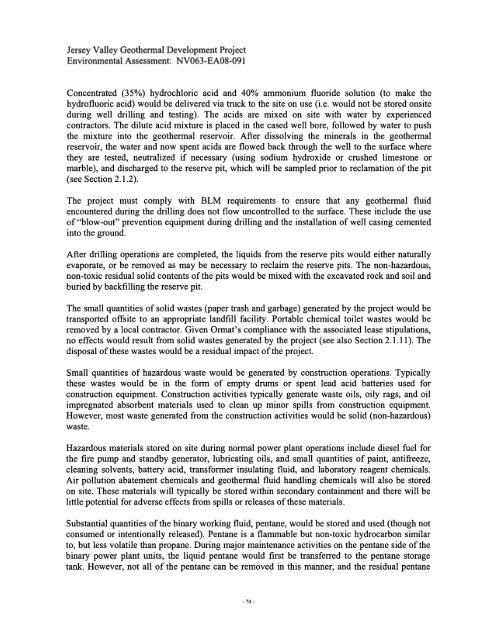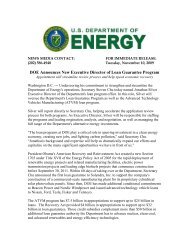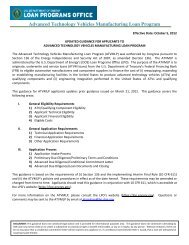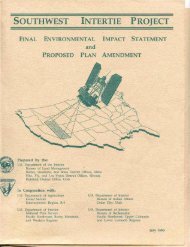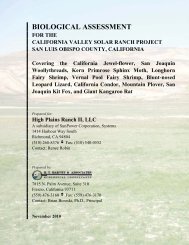Bureau of Land Management's Decision Record and Environmental
Bureau of Land Management's Decision Record and Environmental
Bureau of Land Management's Decision Record and Environmental
You also want an ePaper? Increase the reach of your titles
YUMPU automatically turns print PDFs into web optimized ePapers that Google loves.
Jersey Valley Geothermal Development Project<br />
<strong>Environmental</strong> Assessment: NV063 -EAO8 -091<br />
Concentrated (3 5%) hydrochloric acid <strong>and</strong> 40% ammonium fluoride solution (to make the<br />
hydr<strong>of</strong>luoric acid) would be delivered via truck to the site on use (i.e. would not be stored onsite<br />
during well drilling <strong>and</strong> testing). The acids are mixed on site with water by experienced<br />
contractors. The dilute acid mixture is placed in the cased well bore, followed by water to push<br />
the mixture into the geothermal reservoir. After dissolving the minerals in the geothermal<br />
reservoir, the water <strong>and</strong> now spent acids are flowed back through the well to the surface where<br />
they are tested, neutralized if necessary (using sodium hydroxide or crushed limestone or<br />
marble), <strong>and</strong> discharged to the reserve pit, which will be sampled prior to reclamation <strong>of</strong> the pit<br />
(see Section 2.1.2).<br />
The project must comply with BLM requirements to ensure that any geothermal fluid<br />
encountered during the drilling does not flow uncontrolled to the surface. These include the use<br />
<strong>of</strong> “blow-out” prevention equipment during drilling <strong>and</strong> the installation <strong>of</strong> well casing cemented<br />
into the ground.<br />
After drilling operations are completed, the liquids from the reserve pits would either naturally<br />
evaporate, or be removed as may be necessary to reclaim the reserve pits. The non-hazardous,<br />
non-toxic residual solid contents <strong>of</strong> the pits would be mixed with the excavated rock <strong>and</strong> soil <strong>and</strong><br />
buried by backfihling the reserve pit.<br />
The small quantities <strong>of</strong> solid wastes (paper trash <strong>and</strong> garbage) generated by the project would be<br />
transported <strong>of</strong>fsite to an appropriate l<strong>and</strong>fill facility. Portable chemical toilet wastes would be<br />
removed by a local contractor. Given Ormat’s compliance with the associated lease stipulations,<br />
no effects would result from solid wastes generated by the project (see also Section 2.1.11). The<br />
disposal <strong>of</strong> these wastes would be a residual impact <strong>of</strong> the project.<br />
Small quantities <strong>of</strong> hazardous waste would be generated by construction operations. Typically<br />
these wastes would be in the form <strong>of</strong> empty drums or spent lead acid batteries used for<br />
construction equipment. Construction activities typically generate waste oils, oily rags, <strong>and</strong> oil<br />
impregnated absorbent materials used to clean up minor spills from construction equipment.<br />
However, most waste generated from the construction activities would be solid (non-hazardous)<br />
waste.<br />
Hazardous materials stored on site during normal power plant operations include diesel fuel for<br />
the fire pump <strong>and</strong> st<strong>and</strong>by generator, lubricating oils, <strong>and</strong> small quantities <strong>of</strong> paint, antifreeze,<br />
cleaning solvents, battery acid, transformer insulating fluid, <strong>and</strong> laboratory reagent chemicals.<br />
Air pollution abatement chemicals <strong>and</strong> geothermal fluid h<strong>and</strong>ling chemicals will also be stored<br />
on site. These materials will typically be stored within secondary containment <strong>and</strong> there will be<br />
little potential for adverse effects from spills or releases <strong>of</strong> these materials.<br />
Substantial quantities <strong>of</strong> the binary working fluid, pentane, would be stored <strong>and</strong> used (though not<br />
consumed or intentionally released). Pentane is a flammable but non-toxic hydrocarbon similar<br />
to, but less volatile than propane. During major maintenance activities on the pentane side <strong>of</strong> the<br />
binary power plant units, the liquid pentane would first be transferred to the pentane storage<br />
tank. However, not all <strong>of</strong> the pentane can be removed in this manner, <strong>and</strong> the residual pentane<br />
- 74 -


